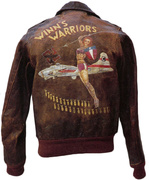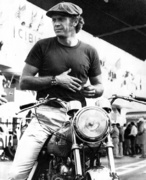
Before the black leather jacket was reduced to another innocuous darling of the fashion world, it was an honored utility—a form of arthropod armor worn by the less-than-gentle men who roamed the fraying fringes of a disquieted society. The original BLJ silhouette, in fact, was donned by German fighter pilots in both World War I and World War II. Throughout the 1930s and ’40s, the U.S. military followed suit, as leather jackets became standard uniforms for both American troops and police officers. However, it would not be long before the citizenry and street urchins seized and subverted this talisman of authority.
“Leather-laden outlaws struck fear into the hearts of civilians and cops alike, as they tore through towns with gleeful irreverence.”
Bikers were the first outsiders to take note of the black leather jacket’s utilitarian value, as their inevitable brawls with gravel meant wearing road rash on their leather rather than their comparatively feeble flesh. In 1928, New York designer Irving Schott introduced the “Perfecto,” a zipped and belted hunk o’ hide that reigned as the ideal BLJ silhouette for decades to come. As Schott’s design was originally distributed by Harley-Davidson, the “Perfecto” soon became the saucily soiled flag flown by the most vicious of motorcycle gangs, most notably, the notorious Hells Angels.
In Hunter S. Thompson’s journalistic inquiry into the infamous biker gang, he writes, “The farther the Angels roam from their own turf, the more likely they are to cause panic. A group of them seen on a highway for the first time is offensive to every normal notion of what is supposed to be happening in this country; it is bizarre to the point of seeming like a bad hallucination … and this is the context in which the term ‘outlaw’ makes real sense.”

The Black Panther Party armored themselves in buttoned black leather in order to present a resistant, unified front in the late ’60s and early ’70s. This photo shows Black Panther leaders Bobby Seale and Huey P. Newton armed, wearing their trademark black leather jackets.
Indeed, the leather-laden outlaws struck fear into the hearts of civilians and cops alike, as they tore through towns with gleeful irreverence. In 1953, the fearful image of the motorcycle gang was cinematically packaged in Laslo Benedek’s “The Wild One,” led by a young Marlon Brando. Aptly encased in Schott’s “Perfecto,” Brando mimed the sexy saunter of a biker-gang leader with magnetic ease. Hence, the black leather jacket was nationally broadcast as rebel-youth emblem, and Brando was dubbed a big-screen bad boy.
Following its Hollywood emergence, the black leather jacket arguably lost some of its sting as it was co-opted by throngs of suburban kiddies looking to sharpen their manicured, mundane, “Leave It to Beaver” lifestyles. However, its subversive edge was maintained on the outskirts, among working-class greasers and, later, by members of the Black Panther Party. As the all-too-harmless hippie movement was relegated to the ’60s, punk rock became a refuge for the battered batch of disillusioned youth in the decade that followed. Righteously ripe with hostility and nihilism, early punkers like Joey Ramone and Sid Vicious (guided by punk’s sartorial godparents, Vivienne Westwood and Malcolm McLaren) were quick to embrace the leather hide of the outsider. And so, the torch was passed. However, this time around, the BLJ finally found favor among women. Joan Jett, Debbie Harry, and Patti Smith, among other female musicians of the moment, relished the utility of the androgynous leather armor.
Perhaps the lingering drip of danger and callousness embedded in a dirty, well-worn black leather jacket is what makes its character so seductive. Perhaps the illusion of elusiveness granted to the wearer is what inspires its unisex appeal. Whatever it may be, it seems rather fitting that the BLJ found its way to the sexual fringes. Initially inspired by the aforementioned hunks on Harleys, gay leather clubs emerged in the late ’50s and continue to flourish. Of course, leather is also often associated with kink, fetishism, and S&M within the greater BDSM community. In 2019, black leather remains a staple at any gay pride parade, regardless of how participants identify, sexually and/or gender-wise. In this sense, the leather menace continues to drape the shoulders of those that make the squares go aquiver.

Winona Ryder took the leather look into the ’90s with style and grace, as seen at “The Commitments” premiere on August 7, 1991, at Pacific’s Cinerama Dome in Hollywood, California. (Photo by Ron Galella, Ltd./Ron Galella Collection via Getty Images)
(Read more about the history of the black leather jacket: “Born to Ride A Brief History of the Motorcycle Jacket,” by Andrew Craig for Grailed; “James Dean, Kate Moss & Other Celebs That Love a Good Leather Jacket,” by Taylor Stephan for E! Online; and “The Black Leather Jacket,” by Mick Farren. To learn more about the biker gang, pick up “Hell’s Angels” by Hunter S. Thompson. If you buy something through a link in this article, Collectors Weekly may get a share of the sale. Learn more.)























 Hollywood's Leading Motorhead: For Steve McQueen, Racing Motorcycles Was No Act
Hollywood's Leading Motorhead: For Steve McQueen, Racing Motorcycles Was No Act
 WWII War Paint: How Bomber-Jacket Art Emboldened Our Boys
WWII War Paint: How Bomber-Jacket Art Emboldened Our Boys Hollywood's Leading Motorhead: For Steve McQueen, Racing Motorcycles Was No Act
Hollywood's Leading Motorhead: For Steve McQueen, Racing Motorcycles Was No Act Behind the Scenes With Janis Joplin and Big Brother, Rehearsing for the Summer of Love
Behind the Scenes With Janis Joplin and Big Brother, Rehearsing for the Summer of Love Military Jackets and CoatsMilitary jackets have long been worn by non-military personnel for their ae…
Military Jackets and CoatsMilitary jackets have long been worn by non-military personnel for their ae… Motorcycle JacketsThe classic, black leather motorcycle jacket dates to 1928, a product of Sc…
Motorcycle JacketsThe classic, black leather motorcycle jacket dates to 1928, a product of Sc… Mari Tepper: Laying it on the Line
Mari Tepper: Laying it on the Line Nice Ice: Valerie Hammond on the Genteel Charm of Vintage Canadian Costume Jewelry
Nice Ice: Valerie Hammond on the Genteel Charm of Vintage Canadian Costume Jewelry How Jim Heimann Got Crazy for California Architecture
How Jim Heimann Got Crazy for California Architecture Modernist Man: Jock Peters May Be the Most Influential Architect You've Never Heard Of
Modernist Man: Jock Peters May Be the Most Influential Architect You've Never Heard Of Meet Cute: Were Kokeshi Dolls the Models for Hello Kitty, Pokemon, and Be@rbrick?
Meet Cute: Were Kokeshi Dolls the Models for Hello Kitty, Pokemon, and Be@rbrick? When the King of Comedy Posters Set His Surreal Sights on the World of Rock 'n' Roll
When the King of Comedy Posters Set His Surreal Sights on the World of Rock 'n' Roll How One Artist Makes New Art From Old Coloring Books and Found Photos
How One Artist Makes New Art From Old Coloring Books and Found Photos Say Cheese! How Bad Photography Has Changed Our Definition of Good Pictures
Say Cheese! How Bad Photography Has Changed Our Definition of Good Pictures Middle Earthenware: One Family's Quest to Reclaim Its Place in British Pottery History
Middle Earthenware: One Family's Quest to Reclaim Its Place in British Pottery History Fancy Fowl: How an Evil Sea Captain and a Beloved Queen Made the World Crave KFC
Fancy Fowl: How an Evil Sea Captain and a Beloved Queen Made the World Crave KFC
Perfect fusion of cutting edge and elegance this beautifully crafted slim fit leather jacket is this season’s must have fashion accessory. Imbued with a classic biker